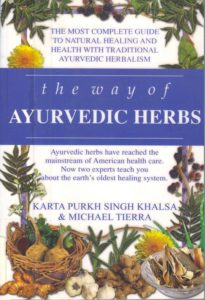
The Way of Ayurvedic Herbs by Karta Purkh Singh Khalsa and Michael Tierra. Published by Lotus Press, 2008. 372 p. ISBN 978-0-9409-8598-8. Tables, Appendix, Glossary, Bibliography, Recommended Reading, Resources.
Suppose that a healer has lived with a medicinal substance, and recognizing its healing power by empirical example, the healer knows the power of that herb on the human body. How different is that from a drugstore bottle of chemicals that we know the name of because we’ve used it over and over again for a headache?
Two different herbal traditions are Ayurvedic medicine and the herbalism of cultures native in the West. Ayurveda, an ancient and complete tradition of healing from South Asia is paired in this post with the traditions and legacy from las curanderas of the American Southwest. Here their review compares medicinal plants and how they are used to promote healing. Why are readers attracted to healing methods from new and unusual sources? Why do readers and seekers think that exotic cures are better than mainstream medicine? As a starting point, it can be said that medicine develops in a culture as a response to the illnesses suffered by the population. Sick people seek cures, however they might be available. On the other hand, medicine is a direct result of the political plan of a particular culture or society.
Today we have mainstream medicine, and as David Hoffmann has suggested, it should be regarded as one means of cure, not disregarded in favor of herbalism, for example. Mainstream or Western medicine is respected throughout the world, especially for life-threatening emergencies, broken bones, and disease. Highly technological, scientific, and laboratory-based, Western medicine provides the rich a means of regaining health. At the same time it’s criticized for perpetuating a bureaucratic system and exposing the sick to multiple levels of a political machine, rather than supplying curative medicine. So we are extremely fortunate to have contact with other ways of thinking about health which we now call alternative medicine.
Alternative systems of medicine originating from other cultures, such as Traditional Chinese Medicine (one example of Chinese medicine) or Ayurveda, a traditional Indian health system, are found in Alternative medicine. They present new ideas about the healing process. Anyone approaching these cultures for medicinal herbs encounters more than an abundance of healing substances. They encounter new philosophies about the ailments of bodily systems, and these philosophies support the choice of healing substances. Discomforts and illnesses in one culture maybe treated with different substances in another culture. And a substance, such as hawthorn berry, may have well-known results as a stomacic in one culture, while in another it is valued for its use as a circulatory agent. Here as well, we are translating the healing philosophy from one language to another, and this involves interpretation, especially when two languages have little in common. Despite an insistence on the best cure, we are truly comfortable with the substance which appeals to us on a sensory level first: if we believe it will have a positive affect we are much closer to healing than if we resist, even if at an emotional level. So the belief system of the sick person, too, is quite important.
Presenting cures from medicinal plants from the Ayurvedic tradition is The Way of Ayurvedic Herbs by Karta Purkh Singh Khalsa and Michael Tierra. Published by Lotus Press, 2008. 372 p. ISBN 978-0-9409-8598-8. Tables, Appendix, Glossary, Bibliography, Recommended Reading, Resources.
And presenting medicinal plants and healing strategies from the local and native cultures of the American Southwest is Infusions of Healing: a Treasury of Mexican American Herbal Remedies, by Joie Davidow. Published by Simon and Schuster, Fireside Books, 1999. 367 p. ISBN 0684854163. Resources, Appendix, and Index.



